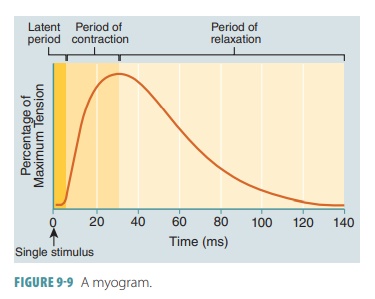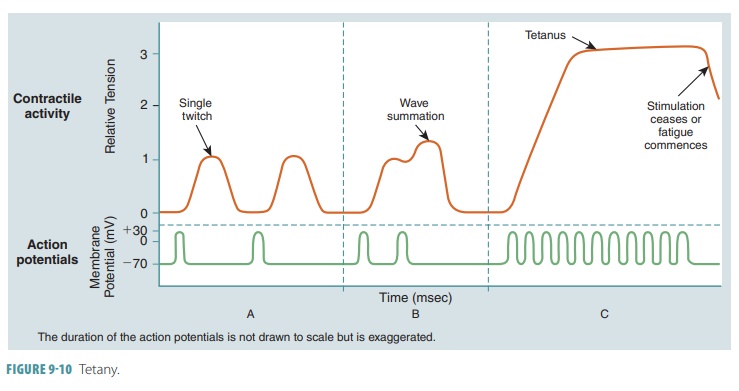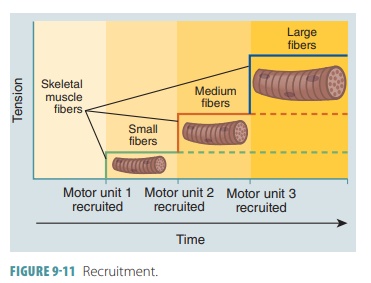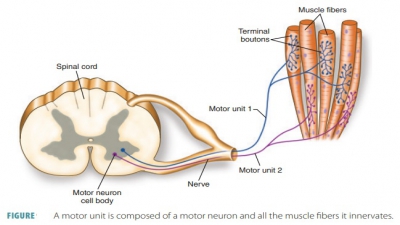Muscle Twitch
| Home | | Anatomy and Physiology | | Anatomy and Physiology Health Education (APHE) |Chapter: Anatomy and Physiology for Health Professionals: Support and Movement: Muscle Tissue
The contractile response of a fiber to an impulse is called a twitch, and it consists of a period of contraction followed by a period of relaxation.
Muscle Twitch
The contractile response of a
fiber to an impulse is called a twitch,
and it consists of a period of contraction followed by a period of relaxation.
A myogram records this pattern of events (FIGURE
9-9). A brief delay occurs between
the stimulation time and the beginning of contraction, known as the latent period, which
may last less than 2 milliseconds (msec). A myogram results from the combined muscle twitches of the
fibers taking part in contraction. There are two types of twitches: the
fatigue-resistant slow twitch and the fatigable fast twitch. In the contraction phase, tension rises to a
peak. This phase ends about 15 msec after stimulation. The relaxation phase lasts about 25 msec and tension falls to resting
levels. If stimulation occurs immediately after the relaxation phase ends, the
next contraction will have a slightly higher maximum ten-sion than the first.
The increase in peak tension will continue to over 30–50 stimulations, but
after that the amount of tension will remain constant. This pattern is known as
treppe.

The force of individual twitches
combines via the process of wave
summation . Stimulation of a mus-cle fiber
for several seconds, with a constant stim-ulus, causes contraction to add up to
a maximum. When sustained contractions have no relaxation at all, they are
referred to as either tetanic
contractions or the condition known as tetany (FIGURE 9-10). A muscle that produces nearly peak tension during rapid
contraction–relaxation cycles is described as being in incomplete tetanus. When
the relax-ation phase is eliminated by a higher stimulation fre-quency, complete tetanus occurs.
High intensities of stimulation can activate many motor units known as recruitment (FIGURE 9-11).


Muscle Tone
Though skeletal muscles are
voluntary, there is still slight contraction even in their relaxed state. This
is known as muscle tone, and occurs because spinal reflexes activate one group of motor units
followed by another group. These actions respond to activated stretch receptors
in skeletal muscles. While active movements are not produced, muscle tone keeps
mus cles firm and healthy so that they are ready to respond when stimulated.
Skeletal muscle tone additionally helps to maintain posture and stabilize joints.
Isotonic and Isometric Contractions
The two primary types of muscle
contractions are termed isotonic and isometric. The electrochemical and
mechanical events that occur inside muscles are identical in both these
contractions, but the results are different:
■■ Isotonic contractions: The
length of the muscle changes and a
load is moved. When enough ten-sion has developed for the needed movement,
tension stays nearly constant through the remain-der of the contractile period.
In an isometric contraction, the thin filaments slide. There are two types of isotonic contractions: concentric and eccentric.
Concentric contractions: The
muscle shortens to perform work.For example, kicking a ball or lifting an
object. Inconcentric contractions, when the elbow is flexed to move a weight
toward the shoulder, the biceps muscle contracts concentrically.
Eccentric contractions: The
muscle creates force as it lengthens.
These contractions are about 50% more forceful than concentric con-tractions
when the same load is moved. How-ever, eccentric
contractions cause delayed onset soreness of
the muscle more often. This maybe because of microtears in the muscle due to the stretching that occurs. An
exam-ple of an eccentric contraction is when the calf muscles are used to climb
a hill. Eccentric contractions also may occur along with con-centric
contractions, such as when the arm is straightened as a load is returned to a
flat surface after the elbow was flexed to move it toward the shoulder. In most
cases, eccentric contractions put the body in position for con-centric
contractions. Examples of activities that used combined eccentric and
concentric contractions include throwing and jumping.
Isometric contractions: The
muscle does not shorten or lengthen.
Instead, tension may build to the muscle’s capacity of peak tension. Examples
include attempting to move a load that is greater than the tension that the
muscle can handle. Iso-metric contractions occur when we maintain our upright
posture or when the joints are held sta-tionary while other joints are moving.
In isomet-ric contractions, the cross-bridges generate force, but the thin
filaments do not move. Therefore, there is no change in the muscles’ banding
pat-terns between the active and resting states.
1. What is
a motor unit?
2. Describe
a muscle twitch.
3. Describe
complete and incomplete tetanus.
4. Compare
isotonic and isometric contractions.
Related Topics

